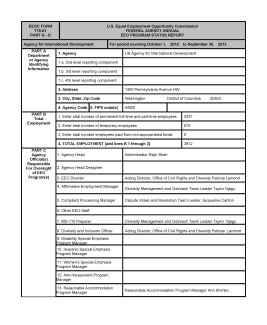USAID’s workforce is comprised of Civil Service employees, Foreign Service Officers, Foreign Service Nationals, Personal Services contractors and Institutional contractors who work in a broad array of professional, technical, scientific, managerial, and operational fields to advance U.S. foreign policy.
As of September 30, 2013, the agency's "U.S. Direct Hire" workforce (Civil Service e and Foreign Service employees) included 3,912 permanent and temporary employees. Women comprised 52.53 percent of the workforce and men comprised 47.47 percent of the workforce.
USAID exceeded the representation of minorities in the National Civilian Labor Force by percent 6.36 percent. The workforce was comprised of 66.00 percent White; 20.76 percent Black/African American; 7.47 percent Asian American/Pacific Islander; 4.88 percent Hispanic/Latino; 0.56 percent American Indian and Alaska Native; and 0.33 percent two or more races.
In FY 2013, USAID increased its workforce representation of Blacks/African Americans, Asian Americans, Hispanics/Latinos, and Individuals with a Targeted Disability from 2012.
Black/African American representation increased by 0.57% to 20.76%--exceeding the corresponding National Civilian Labor Force (NCLF) representation of 10.5%.
USAID’s representation of Black/African Americans in both the career Executive level (Senior Executive Service and Senior Foreign Service) and the career Senior level (GS-15 and FS-01) significantly exceeded their corresponding representation in the Relevant Civilian Labor Force (RCLF) of 8.80%.
- At the Executive level, the representation increased by 2.0% to 13.84%
- At the Senior level, the representation increased by 0.40% to 10.40%.
Asian American representation increased by 0.22% to 7.44%--exceeding the corresponding NCLF level of 3.90% USAID’s representation of Asian Americans in the career Senior level, at 4.76%, exceeded their corresponding representation in the RCLF level of 4.10%.
Hispanic/Latino representation increased by 0.61% to 4.88% (NCLF is 9.96%).
USAID continues to realize results in the employment of individuals with disabilities:
- USAID significantly exceeded its goals for hiring individuals with disabilities pursuant to Executive Order 13548: almost 8.0% of all new Civil Service hires were individuals with disabilities, exceeding the 2013 goal (2.0%) by almost 6.0%.
- The representation of Individuals with a Targeted Disability increased by 0.11% to 0.72%.
USAID recognizes its workforce representation challenges and has developed objectives and strategies to address them. There are three overarching challenges: 1) less than expected representation of Hispanics in both the Civil Service and the Foreign Service; 2) less than expected representation of individuals with Targeted Disabilities; and, 3) less than expected representation of African-Americans, Asian Americans, and Hispanics in select major occupations as identiifed in Part I.

